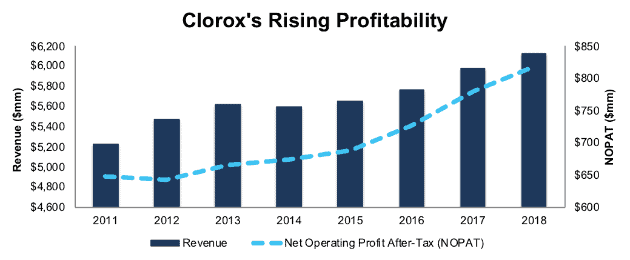Three new stocks make our Dividend Growth Stocks Model Portfolio this month, which was made available to members on September 28, 2018.
Recap from August’s Picks
The best performing stock was up 5%. Overall, 18 out of the 30 Dividend Growth Stocks outperformed the S&P last month, and 18 had positive returns.
The long-term success of our model portfolio strategies highlights the value of our Robo-Analyst technology[1], which scales our forensic accounting expertise (featured in Barron’s) across thousands of stocks[2].
The methodology for this model portfolio mimics an All-Cap Blend style with a focus on dividend growth. Selected stocks earn an Attractive or Very Attractive rating, generate positive free cash flow (FCF) and economic earnings, offer a current dividend yield >1%, and have a 5+ year track record of consecutive dividend growth. This model portfolio is designed for investors who are more focused on long-term capital appreciation than current income, but still appreciate the power of dividends, especially growing dividends.
Featured Stock from September: The Clorox Company (CLX: $152/share)
The Clorox Company (CLX) is the featured stock from September’s Dividend Growth Stocks Model Portfolio. CLX was also a featured Long Idea in September 2017.
Since 2011, CLX has grown revenue by 2% compounded annually while after-tax profit (NOPAT) has grown by 3% compounded annually. NOPAT margin has increased from 12.4% in 2011 to 13.4% in 2018 while return on invested capital (ROIC) has improved from 11% to 12% over the same time.
Figure 1: CLX Revenue & NOPAT Since 2011
Sources: New Constructs, LLC and company filings
Steady Dividend Growth Supported by FCF
The Clorox Company has increased its dividend in each of the past 41 years. The current annualized dividend has grown from $2.87/share in 2014 to $3.60/share in 2018, or 6% compounded annually. Positive FCF has fueled dividend growth in the past and should continue to do so in the future. From 2014-2018, CLX generated $2.8 billion in FCF (14% of market cap), which is above the $2 billion in dividends paid over the same time.
Companies with FCF well in excess of dividend payments provide higher quality dividend growth opportunities because we know the firm generates enough cash to pay a higher dividend. On the flip side, the dividend growth trajectory of a company where FCF falls short of the dividend payment over time cannot be trusted to grow or sustain its dividend because of inadequate free cash flow.
CLX Presents Quality Upside Potential
At its current price of $152/share, CLX has a price-to-economic book value (PEBV) ratio of 1.3. This ratio means the market expects CLX’s NOPAT to grow by no more than 30% over its remaining corporate life. This expectation seems overly pessimistic for a firm that has grown NOPAT by 5% compounded annually over the past two decades.
If CLX can maintain current pre-tax margins (19%), benefit from lower corporate tax rates, and grow NOPAT by just 5% compounded annually over the next decade, the stock is worth $197/share today – a 29% upside. See the math behind this dynamic DCF scenario. Add in CLX’s 2.5% dividend yield and history of dividend growth, and it’s clear why the stock is in the Dividend Growth Stocks Model Portfolio.
Critical Details Found in Financial Filings by Our Robo-Analyst Technology
As investors focus more on fundamental research, research automation technology is needed to analyze all the critical financial details in financial filings. Below are specifics on the adjustments we make based on Robo-Analyst findings in The Clorox Company’s 2018 10-K:
Income Statement: we made $294 million of adjustments with a net effect of removing $4 million in non-operating income (<1% of revenue). See all adjustments made to CLX’s income statement here.
Balance Sheet: we made $4.2 billion of adjustments to calculate invested capital with a net increase of $2.8 billion. The most notable adjustment was $1.7 million (45% of reported net assets) related to goodwill. See all adjustments to CLX’s balance sheet here.
Valuation: we made $3.3 billion of adjustments with a net effect of decreasing shareholder value by $3.1 billion. The largest adjustment to shareholder value was $2.7 billion in total debt, which includes $269 million in off-balance sheet operating leases. This lease adjustment represents 1% of CLX’s market value. Despite the decrease in shareholder value, CLX remains undervalued.
This article originally published on October 4, 2018.
Disclosure: David Trainer and Kyle Guske II receive no compensation to write about any specific stock, style, or theme.
Follow us on Twitter, Facebook, LinkedIn, and StockTwits for real-time alerts on all our research.
[1] Harvard Business School features the powerful impact of our research automation technology in the case New Constructs: Disrupting Fundamental Analysis with Robo-Analysts.
[2] Ernst & Young’s recent white paper “Getting ROIC Right” proves the superiority of our holdings research and analytics.

